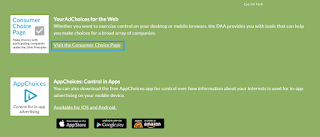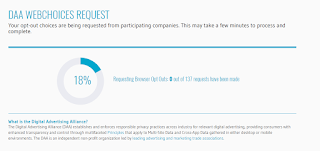There are ads everywhere. The Internet is not the same as it was some years ago. AdChoices is a self-regulatory program for online internet-based advertising that exists in the United States, Canada and across Europe. The program calls for advertising companies to establish and enforce responsible privacy practices for interest-based advertising, aimed to give consumers enhanced transparency and control. Companies adhere to a set of principles that are enforced by accountability programs.
So, there we go. Let's dig into it.
When you're seeing any ad just click on the AdChoices icon to get to your settings. Or alternatively you can directly goto the site of YourAdChoices.
On the home page, head over to Control.
Now select Visit the Consumer Choice Page
It will redirect you to WebChoices.
Then follow the steps in the wizard.
It will take some time and show you the results.
Then hit Continue.
Opt-out the ones you want or simply select all.
After completion, you'll be shown:
Then View Updated Results.
That's it.
This will work until your cookies are preserved. So to prevent your required cookies from bing deleted you can install the Extension Protect My Choices for your browser. This one is for Chrome:
You can find the extention for Firefox, Internet Explorer or any other easily.
So that's how we do it.
So, there we go. Let's dig into it.
When you're seeing any ad just click on the AdChoices icon to get to your settings. Or alternatively you can directly goto the site of YourAdChoices.
| AdChoices Logo |
Now select Visit the Consumer Choice Page
Then follow the steps in the wizard.
It will take some time and show you the results.
Then hit Continue.
Opt-out the ones you want or simply select all.
After completion, you'll be shown:
That's it.
This will work until your cookies are preserved. So to prevent your required cookies from bing deleted you can install the Extension Protect My Choices for your browser. This one is for Chrome:
You can find the extention for Firefox, Internet Explorer or any other easily.
So that's how we do it.










Comments
Post a Comment